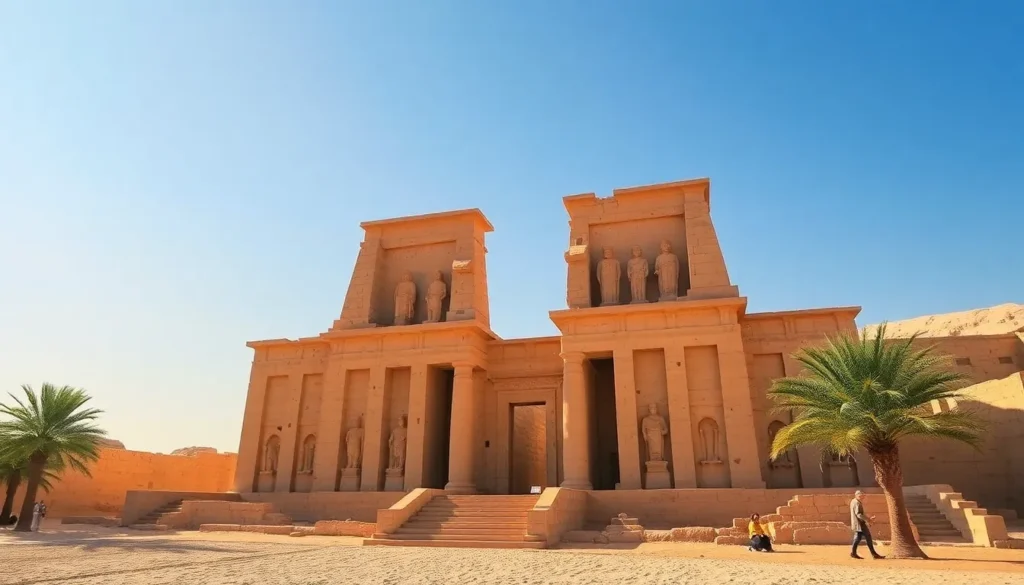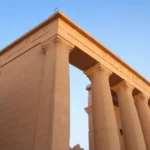Top Temples to Visit in Egypt

- Exploring Egypt's Most Stunning Temples
- The Temple of Luxor: A Marvel of Ancient Architecture
- Karnak Temple: A Complex of Wonders
- The Temple of Hatshepsut: A Tribute to a Powerful Queen
- Temple of Edfu: A Remarkable Preservation
- Temple of Kom Ombo: A Unique Dual Temple
- Temple of Philae: The Island Sanctuary
- Abu Simbel: The Monument of Ramses II
- The Temple of Dendera: A Hidden Gem
- Map of Egypt's Most Beautiful Temples
For those who dream of stepping into a world of ancient mysteries and monumental beauty, the temples of Egypt offer an unmatched experience. These sacred sites, dedicated to gods and pharaohs, stand as a testament to a civilization that flourished thousands of years ago. If you’re planning to explore this enchanting land, prepare to be captivated by the stunning architecture, intricate hieroglyphs, and the rich history that transcends time.
From colossal statues to vast courtyards, each temple narrates stories of divine worship and royal legacy. In this article, we will take you on a virtual journey through the most remarkable temples in Egypt, delving into their significance, architectural marvels, and the historical narratives that continue to intrigue visitors from around the globe. Whether you're looking to visit the best Egyptian temples or explore famous temples in Egypt, this guide will illuminate your path.
Exploring Egypt's Most Stunning Temples
The temples of Egypt serve as time capsules, preserving a glimpse into the past amidst a rapidly changing world. Each temple is a treasure trove of information, revealing secrets about ancient rituals, deities, and the lives of the pharaohs. Here, we present a curated list of the best temples in Egypt that are absolutely essential for anyone seeking to understand the heart of ancient Egypt.
The Temple of Luxor: A Marvel of Ancient Architecture
At the forefront of our exploration is the Temple of Luxor, an architectural masterpiece that has withstood the test of time for over 3,500 years. Located in the ancient city of Thebes (modern-day Luxor), this temple was dedicated to the god Amon.
- **Historical Significance:** Built during the reigns of Amenhotep III and Ramses II, the temple is a symbol of the grandeur of the New Kingdom.
- **Architectural Wonders:** The temple features an impressive entrance flanked by six colossal statues of Ramses II, which provide a breathtaking welcome.
- **Interesting Facts:** The temple was rediscovered in 1884 and is linked to the Karnak Temple by a grand avenue once adorned with hundreds of sphinxes.
Visitors to Luxor find themselves enveloped by its history, from the massive stone columns to the well-preserved frescoes that tell tales of the past.
Karnak Temple: A Complex of Wonders
Next on the list is the Karnak Temple, a sprawling complex that comprises several temples, including those dedicated to Amon, Mut, and Montu. The most famous feature is the Great Hypostyle Hall, filled with towering columns covered in hieroglyphs that illuminate the brilliance of ancient Egyptian artistry.
- **Granite Columns:** The hall boasts 134 columns, some reaching heights of 21 meters, showcasing how the Egyptians mastered stonework.
- **Symbolism:** Each column and relief has a story, often depicting the pharaohs’ achievements and their connections to the divine.
- **Obelisks:** The site is home to several monumental obelisks, including the one erected by Hatshepsut, which stands at nearly 30 meters tall.
Exploring Karnak is like walking through a living museum where every stone whispers the glories of a bygone era.
The Temple of Hatshepsut: A Tribute to a Powerful Queen
Dedicated to one of Egypt's few female pharaohs, Hatshepsut, this temple is carved into the cliffs of Deir el-Bahari. Its unique design and beautiful terraces make it stand out among the temples.
- **Architectural Innovation:** It features three distinct terraces connected by long ramps, creating a striking visual effect.
- **Historical Context:** Hatshepsut ruled dressed as a man, defying the norms of her time, and her temple celebrates her legacy.
- **Cultural Significance:** The temple was adorned with reliefs that depicted her divine birth and her trading expeditions, though many were vandalized after her death.
Visitors often feel a sense of reverence here, standing before the structure that symbolizes female power in a patriarchal society.
Temple of Edfu: A Remarkable Preservation
The Temple of Edfu is considered the best-preserved temple in Egypt, dedicated to the falcon-headed god Horus. Its construction began in 237 BC and concluded in 57 BC, showcasing the architectural prowess of the Ptolemaic era.
- **Design Features:** The entrance is flanked by two giant statues of Horus, welcoming visitors into a world steeped in mythology.
- **Religious Importance:** The temple served as a center for the worship of Horus and was the site of elaborate rituals.
- **Artwork:** The walls are adorned with intricate carvings and hieroglyphs that narrate the legendary battles between Horus and Seth.
Exploring Edfu offers a deeply immersive experience, with each corner unveiling a fragment of ancient spirituality.
Temple of Kom Ombo: A Unique Dual Temple
Located on the banks of the Nile, the Temple of Kom Ombo is unique in its design, featuring two symmetrical halves dedicated to the crocodile god Sobek and the falcon god Horus. Built during the Ptolemaic period, this temple is notable for its dual sanctuaries.
- **Architectural Layout:** Each side of the temple is dedicated to a different deity, allowing for a fascinating exploration of ancient beliefs.
- **Medical Reliefs:** The temple is famous for its carvings depicting surgical instruments, showcasing the medical knowledge of the time.
- **Nilometer:** An ancient nilometer is located outside, used to measure the Nile's water levels for agricultural assessments.
Visitors often marvel at the harmonious coexistence of the two distinct worship styles, reflecting the complexity of ancient Egyptian religion.
Temple of Philae: The Island Sanctuary
Set on an island in Lake Nasser, the Temple of Philae is a stunning homage to the goddess Isis. Its picturesque location makes it one of the most beautiful temples in Egypt.
- **Access by Boat:** Visitors must take a short boat ride to reach the temple, adding to its allure.
- **Historical Preservation:** Like Abu Simbel, Philae was relocated to higher ground to prevent flooding from the Aswan High Dam.
- **Christian Heritage:** The temple features Christian symbols carved by early Christians who sought refuge here, blending two eras of history.
Philae’s serene environment and breathtaking architecture provide a tranquil escape, allowing visitors to reflect on its historical significance.
Abu Simbel: The Monument of Ramses II
The Abu Simbel temples are perhaps the most striking monuments in Egypt, showcasing the grandeur of Ramses II. Carved directly into the mountainside, these temples are marvels of engineering and artistry. Often associated with the term "abu simbel civitatis," they symbolize the resilience of ancient Egyptian culture.
- **Colossal Statues:** The four massive statues of Ramses II stand guard over the entrance, each portraying the pharaoh as a god among men.
- **Solar Alignment:** The temple is designed so that twice a year, the sun illuminates the inner sanctum, a testament to the Egyptians’ understanding of astronomy.
- **Relocation Efforts:** When the Aswan Dam was constructed, the temples were painstakingly relocated to prevent flooding, a monumental task that showcased international cooperation.
Visiting Abu Simbel is an unforgettable experience, especially at sunrise when the sunlight bathes the statues in a golden hue. It is undoubtedly one of the best Egyptian temples to visit.
Located about two hours from Luxor, the Temple of Dendera is dedicated to Hathor, the goddess of love and joy. Unlike many other temples, Dendera is less frequented by tourists, making it a hidden treasure. This temple is considered one of the famous temples in Egypt due to its unique features.
- **Stunning Reliefs:** The temple features detailed reliefs and carvings that depict scenes of worship and celebration.
- **Astronomical Significance:** Its ceiling boasts a stunning depiction of the night sky, complete with constellations.
- **Accessibility:** A short taxi ride or organized tour from Luxor makes it easy to include this site in your itinerary.
Exploring Dendera allows visitors to appreciate the artistry of ancient Egypt without the crowds, enhancing the experience.
Map of Egypt's Most Beautiful Temples
To help you navigate your adventure through Egypt, here’s an interactive map highlighting the locations of the temples we’ve discussed. This valuable tool will ensure you don’t miss any of these historical wonders.
As you embark on your journey through Egypt, the temples will leave a lasting impression, urging you to delve deeper into the stories they hold. Each visit is not just a glimpse into the past but an invitation to connect with a civilization that continues to inspire awe.
For a deeper visual exploration of Egypt's magnificent temples, check out this insightful video:
| Save on your trip |
| Compare and find cheap flights here |
| Find accommodations at the best prices here |
| Book activities and excursions in Spanish here |
| Get a 5% discount on your travel insurance IATI here |
| Book airport transfers here |
| Learn how to withdraw money without fees here |
| Get a 5% discount on your eSIM from Holafly here |
| The best books and travel guides here |
| All our articles about Egypt |




Deja una respuesta